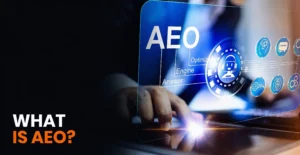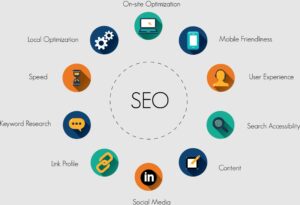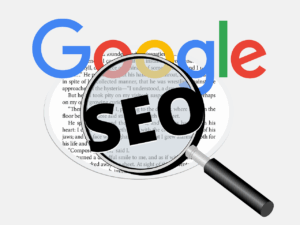What Is Umbraco CMS and How Does It Compare to Other Enterprise Platforms in 2025?
What Is Umbraco CMS and Why Is It Popular in 2025? Umbraco CMS is a leading content management system that has earned global recognition for delivering enterUmbraco CMS development offers…
How a GEO Marketing Agency Helps Multilocation Brands Improve Local Visibility
How Do Multilocation Brands Benefit From Partnering With A GEO Marketing Agency? A GEO marketing agency specializes in optimizing local search presence for businesses operating across multiple locations, ensuring each…
SEO and EEAT: What Every Professional Needs to Know
Search engine optimization (SEO) has always been at the forefront of digital marketing strategies, but as Google’s algorithms grow more sophisticated, it’s becoming clear that SEO is no longer just…

Builds Worth SEO
Certified SEO/SEM Company
ROI Centric Strategies
Register Yourself Immediately While The
Quota Is Still Available And Become Part Of US!
What Is Builds Worth SEO?
Results-driven Approach
(SEO)
Builds Worth SEO is known for its results-driven approach. They are committed to delivering tangible outcomes for their clients in terms of increased organic traffic, higher search engine rankings, and improved online visibility. They set clear goals and objectives at the beginning of each project and employ strategies tailored to the specific needs and objectives of their clients.
Expertise in Search Engine Optimization (SEO)
Builds Worth SEO demonstrates a high level of expertise in the field of SEO. They possess a deep understanding of search engine algorithms, keyword research, on-page and off-page optimization techniques, and content strategy. With their knowledge and experience, they can effectively analyze and optimize websites to improve their visibility in search engine rankings.
Transparent and Ethical Practices
Builds Worth SEO operates with transparency and integrity. They believe in ethical SEO practices that comply with search engine guidelines and best industry standards. They maintain open lines of communication with their clients, keeping them informed about the progress, strategies, and results of their SEO campaigns.
[ BEST SEO SERVICES ]
RankBoost Pro

ContentOptiMax

LocalReach Pro

[ CLIENTS TESTIMONAIL ]
I can't say enough good things about Builds Worth SEO. They have been instrumental in helping us dominate our industry's online search results. Since partnering with them, our website has experienced a tremendous increase in visibility, and we've seen a significant improvement in lead generation and customer acquisition. The Builds Worth SEO team is not only highly skilled but also incredibly proactive and collaborative. They took the time to understand our business goals and tailored their strategies accordingly. Working with them has been a pleasure, and we look forward to achieving even greater success together.



[ BLOGS ]

What Is Umbraco CMS and How Does It Compare to Other Enterprise Platforms in 2025?
What Is Umbraco CMS and Why Is It Popular in 2025? Umbraco CMS is a leading content management system that has earned global recognition for delivering enterUmbraco CMS development offers enterprise-grade capabilities without the complexity typically associated with large-scale platforms. Built on a flexible, open-source foundation, it powers everything from small business websites to high-traffic global platforms trusted by professional companies worldwide. The platform’s popularity stems from three core strengths: Flexibility: Umbraco CMS features a fully composable architecture that integrates seamlessly with e-commerce, analytics, CRM, and personalisation tools — all without vendor lock-in. Ease of use: Content editors can manage and update websites intuitively, requiring no specialised training or technical knowledge. Fast ROI: Businesses typically achieve a return on investment within 11 months, with average go-live times around 4 months. This combination makes Umbraco CMS development ideal for businesses of all sizes seeking the perfect balance between developer customisation and marketer-friendly content management. Its ability to deliver enterprise functionality while maintaining accessibility positions it as a strong alternative to more complex systems in 2025. How Does Umbraco Support Modern Enterprise Needs? Umbraco’s composable architecture eliminates vendor lock-in by allowing businesses to select and integrate best-of-breed tools rather than being confined to a single vendor’s ecosystem. This architectural approach gives enterprises complete control over their digital experience stack, enabling them to swap components as business requirements evolve without costly platform migrations. The platform seamlessly connects with essential enterprise systems through robust API-driven integrations: This flexibility transforms Umbraco into a central hub for your digital experience strategy. Marketing teams can orchestrate campaigns across multiple touchpoints whilst technical teams maintain the freedom to implement specialised tools for specific functions. The composable foundation means enterprises aren’t forced into expensive all-in-one solutions that often include features they’ll never use, reducing both licensing costs and technical complexity. What Are the Key Trends Shaping CMS Platforms in 2025? AI-driven content creation has transformed how organizations produce and manage digital experiences. Modern platforms now leverage artificial intelligence to generate content suggestions, optimize headlines, and automate routine editorial tasks. Personalization engines use machine learning algorithms to analyse user behaviour patterns, delivering tailored content experiences that increase engagement and conversion rates. Security enhancements powered by machine learning have become non-negotiable for enterprise platforms. These systems detect anomalies in real-time, identify potential threats before they materialise, and automatically patch vulnerabilities. Advanced threat detection models learn from global attack patterns, providing proactive protection against emerging cyber risks. Read more about AI data security. The shift toward composable CMS architectures represents a fundamental change in how enterprises build their digital ecosystems. Organizations demand platforms that connect seamlessly with specialized tools through APIs—from marketing automation and analytics to e-commerce and customer data platforms. This modular approach eliminates dependency on single vendors whilst enabling businesses to select best-of-breed solutions for each function. ROI-centric strategies now drive platform selection, with companies prioritising systems that demonstrate measurable business value quickly. How Does Umbraco Align With These 2025 CMS Trends? Umbraco’s flexible architecture positions it at the forefront of 2025’s CMS evolution by seamlessly integrating with AI-powered tools and personalisation engines. The platform’s composable foundation allows businesses to connect best-of-breed AI solutions through APIs, enabling content teams to leverage machine learning for automated content suggestions, predictive analytics, and audience-specific experiences without being locked into proprietary systems. AI integration Umbraco capabilities extend through: The platform’s security features have evolved to meet 2025’s threat landscape through machine learning-driven monitoring systems that detect anomalies in real-time. Umbraco’s open-source foundation benefits from continuous community-driven security audits whilst maintaining enterprise-grade protection layers. Regular automated updates and vulnerability scanning ensure businesses stay protected against emerging threats without manual intervention, addressing the critical security demands enterprises face today. How Does Umbraco Compare to Other Enterprise Platforms Like Sitecore? Umbraco vs Sitecore comparison reveals distinct approaches to enterprise content management. Umbraco delivers a balanced platform where developers enjoy extensive customisation options whilst non-technical users navigate an intuitive interface requiring minimal training. Sitecore presents a more complex ecosystem with steeper learning curves for both technical teams and content editors. The platform demands significant investment in specialised expertise, often requiring dedicated Sitecore developers to maintain and extend functionality. Licensing costs for Sitecore can escalate quickly, particularly when scaling across multiple sites or adding advanced features. Umbraco’s open-source foundation combined with enterprise-grade capabilities provides cost-effective scalability. Businesses avoid the hefty licensing fees associated with proprietary platforms whilst maintaining full control over their digital infrastructure. The platform’s composable architecture allows organisations to integrate best-of-breed tools without being locked into a single vendor’s ecosystem—a flexibility that Sitecore’s tightly integrated suite doesn’t readily accommodate. Content teams can manage updates independently, reducing reliance on technical resources and accelerating time-to-market for digital initiatives. What Are the Market Recognitions That Validate Umbraco’s Leadership? Umbraco has earned G2 leader 2025 awards across multiple critical categories, cementing its position as a top-tier enterprise CMS. The platform achieved leader status in Web Content Management (WCM), Headless CMS, and Digital Experience Platforms (DXP) for 2025—a rare trifecta that demonstrates its versatility across different implementation approaches. The recognition extends beyond general leadership categories. Umbraco ranks at the top in both mid-market and small business segments, whilst maintaining high performer status at the enterprise level. This breadth of recognition reflects the platform’s ability to scale effectively regardless of organisation size. These G2 accolades are based on verified user reviews and satisfaction scores, making them particularly valuable indicators of real-world performance. The awards validate Umbraco’s claims about usability, flexibility, and ROI delivery through authentic customer experiences rather than marketing assertions alone. How Fast Is Umbraco to Set Up and Deliver ROI Compared to Competitors? Umbraco delivers measurable business value faster than most enterprise CMS platforms, with an average go-live time of just 4 months from project initiation to launch. This rapid deployment timeline stems from the platform’s intuitive architecture and straightforward implementation process. The setup time Umbraco comparison against traditional enterprise systems reveals a significant advantage. Where legacy platforms often require 6-12 months of configuration, Umbraco’s streamlined approach reduces technical overhead. Development teams can build and deploy sites efficiently without navigating complex licensing structures or proprietary frameworks that slow progress. ROI materialises equally quickly. Businesses typically achieve return on investment within 11 months of launch—substantially faster than competing enterprise solutions that may take 18-24 months. This accelerated value delivery comes from: The platform’s composable nature allows organisations to start lean and scale functionality as needs evolve, avoiding the bloated implementations that plague many enterprise CMS projects. What Makes Umbraco a Competitive Choice for Enterprises in 2025? Umbraco delivers three critical advantages that position it ahead of traditional enterprise platforms: no vendor lock-in, significantly lower licensing costs, and the open-source enterprise CMS benefits that allow unlimited customisation without proprietary restrictions. The platform’s composable architecture means enterprises can integrate best-of-breed tools across their digital ecosystem—from e-commerce to CRM—without being forced into a single vendor’s suite of products. This flexibility translates directly into cost savings, as businesses pay only for the capabilities they need rather than bundled features they’ll never use. What Is Umbraco CMS and How Does It Compare to Other Enterprise Platforms in 2025? The answer lies in its unique positioning: enterprise-grade functionality with developer-friendly flexibility, wrapped in an interface that empowers marketers to work independently. Whilst competitors like Sitecore demand extensive technical resources and carry premium licensing fees, Umbraco achieves the same outcomes with faster implementation times and lower total cost of ownership. For enterprises seeking agility, cost efficiency, and genuine control over their digital experience, Umbraco represents the modern standard in content management. FAQs –What Is Umbraco CMS and How Does It Compare to Other Enterprise Platforms in 2025

How a GEO Marketing Agency Helps Multilocation Brands Improve Local Visibility
How Do Multilocation Brands Benefit From Partnering With A GEO Marketing Agency? A GEO marketing agency specializes in optimizing local search presence for businesses operating across multiple locations, ensuring each site appears prominently in its specific geographic market. These agencies deploy location-based strategies that connect multilocation brands with nearby customers actively searching for their products or services. Local visibility directly impacts foot traffic and revenue for businesses with physical locations. When each branch ranks well in local search results, the brand captures more qualified leads ready to visit or purchase. Without proper geographic optimization, even well-known brands risk losing customers to competitors who appear first in “near me” searches. Partnering with a GEO marketing agency delivers measurable advantages: This specialized expertise helps multilocation brands scale their local presence efficiently whilst maintaining brand integrity across diverse markets. What Is Local SEO Optimization And Why Is It Crucial For Each Location? Local SEO optimization targets geographically specific search queries to help individual business locations appear in relevant local search results. When customers search for “coffee shop near me” or “plumber in Manchester,” local SEO determines which businesses appear in the coveted map pack and organic listings. Each location requires its own optimized presence because search engines treat every physical address as a distinct entity. A restaurant chain with 50 locations needs 50 separate, fully optimized profiles to capture local search traffic effectively. NAP consistency forms the foundation of successful local SEO. Name, address, and phone number data must match exactly across: Beyond accurate NAP data, each profile demands location-specific categories, detailed descriptions incorporating geo-specific keywords, high-quality photos, operating hours, and service area definitions. This granular optimization ensures search engines confidently display the right location to nearby searchers. How Does Geo-Tagging Improve Search Rankings And User Engagement? Geo-tagging embeds geographical metadata directly into images, videos, and other digital content, signalling to search engines the precise location where that content is relevant. This metadata includes coordinates, city names, and regional identifiers that help search algorithms understand which audiences should see your content. Search engines prioritise localized content that matches a user’s geographic intent. When a potential customer searches “coffee shop near me” or “plumber in Manchester,” geo-tagged content appears more prominently because the metadata confirms its relevance to that specific area. This location context directly impacts ranking positions in local search results. User engagement improves significantly when people encounter content tailored to their immediate surroundings. Geographical metadata enables multilocation brands to serve location-specific offers, events, and store information automatically. A customer in Leeds sees Leeds-specific promotions, whilst someone in Bristol receives Bristol-relevant content—creating personalized experiences that drive higher click-through rates and longer session durations. This targeted approach transforms generic brand messaging into meaningful local interactions that resonate with community-specific needs and preferences. Why Is Centralized Management With Local Flexibility Important For Brand Consistency? Centralized management with local flexibility prevents brand fragmentation whilst empowering individual locations to connect with their specific communities. Platforms like Mobilosoft, Uberall, and Yext enable multilocation brands to maintain unified messaging, visual identity, and core business information across hundreds or thousands of locations from a single dashboard. These systems allow headquarters to set non-negotiable brand standards—logos, colour schemes, service descriptions, and approved messaging—whilst granting local managers permission to customize elements that resonate with their neighbourhood. A restaurant chain might enforce consistent menu descriptions centrally but allow individual locations to highlight locally popular dishes or community events. This dual approach addresses a critical challenge: maintaining recognizable brand identity without sacrificing the authentic local presence that drives customer trust. Local teams can respond to area-specific customer reviews, update holiday hours for regional observances, and adjust content for cultural relevance—all within guardrails that protect brand integrity. The result is a cohesive brand experience that feels personally relevant at every location. What Impact Do Customer Reviews Have On Local Trust And Visibility? Customer reviews directly influence how prominently each location appears in local search results and whether potential customers choose to visit. Google’s algorithm prioritises businesses with higher review volumes and ratings, pushing them up in local pack rankings and map results. Active reputation management transforms reviews into powerful trust signals. Each location needs a systematic approach to collecting feedback immediately after customer interactions—through SMS requests, email follow-ups, or in-store prompts. Responding to every review, positive or negative, demonstrates commitment to customer satisfaction and keeps listings active in search algorithms. The impact on local trust extends beyond rankings. Research shows 87% of consumers read online reviews before visiting local businesses, with recent reviews carrying the most weight. A location with 50+ reviews averaging 4.5 stars will consistently outperform competitors with fewer reviews, even if those competitors have perfect 5-star ratings. Negative reviews, when addressed professionally and promptly, can actually strengthen credibility by showing authentic customer engagement and problem resolution. How Can Geolocalized Advertising Drive Store Traffic Effectively? Geolocalized advertising targets potential customers within specific geographic boundaries through paid campaigns on platforms like Google Ads, Facebook, and Instagram. These geo-targeted ads use location data to display promotions exclusively to users near a particular store location, ensuring marketing budgets reach the most relevant audiences. The precision of geo-targeted campaigns allows brands to: Success measurement extends beyond digital metrics. Advanced tracking connects online ad exposure to offline behaviour through: A restaurant chain running geo-targeted ads within a 5km radius during lunch hours can directly measure the increase in dine-in customers, providing clear ROI data that justifies continued investment in location-specific advertising strategies. How Does Content Localization Improve Engagement And SEO For Each Location? Content localization transforms generic brand messaging into hyper-relevant experiences that resonate with specific communities. A GEO marketing agency creates unique website pages for each location featuring neighbourhood-specific keywords, local landmarks, and community events that search engines prioritise when users search for nearby services. Local content marketing extends beyond websites to social media platforms where each location’s profile shares posts about: This approach directly impacts search engine rankings because Google’s algorithms favour content demonstrating genuine local relevance. When a GEO marketing agency helps multilocation brands improve local visibility through tailored content, each location appears more authoritative in its specific market. User engagement metrics improve dramatically when customers encounter content reflecting their immediate environment. Location-specific landing pages with locally optimised meta descriptions, headers, and imagery increase click-through rates whilst reducing bounce rates—signals that boost organic search performance across all locations. Visit https://www.business.qld.gov.au/running-business/marketing-sales/marketing/websites-social-media/seo to get more about SEO. What Role Do Analytics And Reporting Play In Optimising Local Marketing Performance? Analytics tools and reporting transform raw data into actionable insights that drive better local marketing decisions. GEO marketing agencies track visibility metrics like search impressions, map views, and click-through rates for each location, revealing which stores perform well and which need attention. Customer interaction data—including calls, direction requests, website visits, and booking conversions—provides a complete picture of how audiences engage with each location. This granular tracking identifies patterns such as peak engagement times, preferred contact methods, and conversion bottlenecks specific to individual stores. Data-driven optimisation allows agencies to: Reporting dashboards consolidate performance across all locations, making it simple to compare results and spot trends. When a location’s visibility drops or engagement stalls, agencies can quickly diagnose issues—whether it’s outdated NAP data, negative reviews, or weak local content—and implement targeted fixes that restore performance. Other Resources : What Is Umbraco CMS and How Does It Compare to Other Enterprise Platforms in 2025? What Challenges Do GEO Marketing Agencies Face When Managing Multilocation Brands? Managing hundreds or thousands of business locations creates significant listing consistency challenges that can undermine local visibility efforts. Keeping NAP data accurate across Google Business Profile, Apple Business Connect, Bing Places, and dozens of other directories requires constant vigilance, as even minor discrepancies—like “Street” versus “St.”—can confuse search engines and harm rankings. The brand messaging balance presents an equally complex challenge. Agencies must preserve core brand identity whilst allowing each location to speak authentically to its local market. Too much standardization makes content feel generic and disconnected from the community. Too much localization risks fragmenting the brand’s voice and diluting recognition. These challenges intensify when: Addressing these obstacles demands robust systems, clear protocols, and specialized expertise that most multilocation brands lack internally. Why Should Multilocation Brands Engage A GEO Marketing Agency For Growth? Multilocation brands that partner with a GEO marketing agency gain access to specialized expertise that transforms local visibility into measurable business growth. These agencies possess the technical knowledge, platform relationships, and strategic frameworks needed to improve local visibility across dozens or hundreds of locations simultaneously. The complexity of managing local SEO, review responses, geo-targeted advertising, and location-specific content requires dedicated professionals who understand the nuances of how a GEO marketing agency helps multilocation brands improve local visibility. Internal teams often lack the bandwidth or specialized skills to execute these strategies effectively at scale. Key advantages of professional GEO marketing support include: Ready to dominate local search results in every market you serve? Connect with a GEO marketing agency that understands your multilocation challenges and can deliver consistent, scalable results that drive foot traffic and revenue growth. FAQs-How a GEO Marketing Agency Helps Multilocation Brands Improve Local Visibility

The Ultimate Guide to Local SEO: Get Found by Customers Near You
Introduction Picture this: You own a cozy café in your town. The coffee is rich, the pastries are warm, and your service is top-notch. Yet, people across the street are still choosing a competitor because they found them on Google when searching “best café near me.” This happens all the time—not because your business isn’t great, but because your online presence isn’t optimized for Local SEO. In simple terms, Local SEO (Search Engine Optimization) is about making your business visible online to people in your area who are actively looking for what you offer. For small businesses, it’s one of the most powerful tools to attract nearby customers, increase foot traffic, and grow sales. Let’s break down everything you need to know to dominate your local market online. See more: SEO and EEAT: What Every Professional Needs to Know What Is Local SEO? Local SEO is the process of optimizing your business’s online presence to show up in search results when people nearby search for products or services you provide. Instead of trying to compete with global brands on broad terms like “best pizza”, Local SEO targets searches like “best pizza in Brooklyn” or “pizza delivery near me.” Key elements of Local SEO include: In short, it ensures you’re visible exactly when local customers are ready to buy. Why Local SEO Matters for Small Businesses Local SEO is essential because consumer behavior has shifted. Most people pull out their phone and Google what they need before making a purchase. Here’s why small businesses can’t ignore it: Without Local SEO, your business risks being invisible to the very people most likely to walk through your door. Key Benefits of Local SEO Essential Local SEO Strategies 1. Optimize Your Google Business Profile This is your digital storefront on Google. Add your business name, address, phone number, hours, photos, and updates. Keep it accurate and up to date. 2. Use Local Keywords Incorporate phrases like “plumber in Dallas” or “organic bakery Chicago” into your website content, titles, and blog posts. 3. Collect and Respond to Reviews Encourage happy customers to leave reviews on Google, Yelp, or Facebook. Always respond politely—even to negative reviews. 4. Mobile Optimization Most local searches happen on smartphones. Ensure your website is mobile-friendly, loads fast, and has click-to-call buttons. 5. Local Citations Consistency is key. Make sure your business name, address, and phone number (NAP) are identical across all directories like Yelp, TripAdvisor, and Yellow Pages. 6. Build Local Backlinks Partner with local bloggers, newspapers, or organizations for backlinks that boost your authority. Common Mistakes Small Businesses Make with Local SEO These mistakes may seem small, but they can keep your business from showing up in local searches. Practical Examples of How Local SEO Works Tips for Small Businesses to Get Started with Local SEO Conclusion Local SEO isn’t just another digital marketing tactic—it’s a lifeline for small businesses trying to stand out in competitive neighborhoods. It helps you appear where customers are looking, builds credibility through reviews, and turns online searches into real-world sales. If you want to dominate your local market, now is the time to act. Start small—optimize your Google Business Profile, gather reviews, and use local keywords. Over time, these steps will bring more visibility, more foot traffic, and more loyal customers through your doors. Local SEO is not an expense—it’s an investment in your long-term growth. Get started today, and let your business be the first choice in your neighborhood tomorrow.

SEO and EEAT: What Every Professional Needs to Know
Search engine optimization (SEO) has always been at the forefront of digital marketing strategies, but as Google’s algorithms grow more sophisticated, it’s becoming clear that SEO is no longer just about keywords and backlinks. In 2025, the concept of EEAT (Experience, Expertise, Authoritativeness, and Trustworthiness) has emerged as a pivotal factor in determining a website’s credibility and ranking. As Google shifts towards evaluating content quality and user trust, it’s crucial for SEO professionals to understand how EEAT directly influences SEO performance. This article delves into the importance of EEAT for SEO in 2025, how it complements both on-page and off-page SEO strategies, and how you can implement it to boost your site’s rankings. We’ll explore practical strategies to enhance your website’s EEAT, common pitfalls to avoid, and the techniques that are still effective in today’s SEO landscape. What is EEAT and Why Does It Matter for SEO? In 2025, EEAT has become an integral part of SEO. Google introduced this concept as part of its effort to ensure that users are presented with the most reliable, accurate, and helpful content. While the term has been around for some time, its importance in SEO has intensified in recent years. Here’s a breakdown of EEAT: Experience Experience refers to the real-world knowledge and firsthand expertise that content creators bring to their material. This is particularly important for industries such as health, finance, and legal, where users need to trust the information they receive. Expertise Expertise indicates that the content is created by someone who has proven knowledge in the subject matter. For example, a medical blog written by a licensed doctor carries more weight than one written by a general blogger. Authoritativeness Authoritativeness means that a website is recognized as a leader in its field. Websites with authoritative backlinks, a history of valuable content, and industry recognition are often seen as more credible by search engines. Trustworthiness Trustworthiness ensures that a website can be relied upon. This includes factors like secure browsing (HTTPS), user reviews, accurate information, and privacy policies. Google prioritizes trustworthy websites to ensure users don’t fall victim to misinformation or security risks. How EEAT Affects Your SEO Strategy Google’s ranking algorithms now consider EEAT signals when determining how well a website should rank in search results. In practical terms, EEAT has a significant impact on both on-page and off-page SEO strategies, influencing factors like content quality, backlinks, and site authority. 1. On-Page SEO and EEAT On-page SEO refers to everything on your website that can be optimized to improve rankings. For EEAT, on-page elements need to reflect authority, trust, and expertise. Content Quality and Relevance The quality of your content is the most significant driver of EEAT. In 2025, content that is comprehensive, accurate, and written by experts is more likely to rank highly. Content should provide value to users by answering their queries with authoritative information. Clear Author Information Google values transparency. Displaying clear author credentials can significantly impact your EEAT score. If you are in a sensitive industry like healthcare or law, showing qualifications and certifications can boost credibility. 2. Off-Page SEO and EEAT Off-page SEO refers to factors that occur outside of your website but still influence its rankings, such as backlinks, social media presence, and online reviews. Off-page elements play a huge role in signaling trustworthiness and authority. Backlink Quality and Relevance Backlinks from authoritative and trustworthy websites directly contribute to your website’s EEAT score. Google evaluates the quality, relevance, and trustworthiness of the sites linking back to you. Social Proof and Reviews Customer reviews and social media mentions are powerful trust signals. Google pays attention to user-generated content, like reviews and social media posts, which affect your reputation and perceived trustworthiness. 3. Mobile-First Indexing and EEAT As mobile-first indexing becomes the norm, ensuring your site provides a seamless mobile experience is essential for both UX and SEO. Google uses the mobile version of your website for ranking and indexing, so optimizing your mobile site is crucial for improving your EEAT signals. 4. User Experience (UX) and Trustworthiness Google has increasingly incorporated UX as a ranking factor, which is closely related to EEAT. A website that offers a smooth, intuitive experience builds trust and authority with users. Outdated SEO Techniques to Avoid in 2025 As SEO evolves, some outdated practices no longer hold weight or even harm your rankings. Here are some techniques to avoid in the age of EEAT: How to Improve EEAT for Better SEO Improving your EEAT signals can significantly boost your SEO performance. Here are some practical strategies to consider: Summary and Actionable Checklist In 2025, SEO is no longer just about optimizing for search engines—it’s about providing value and earning the trust of both users and search engines. The concept of EEAT plays a vital role in this, as Google increasingly focuses on content quality, authority, and trustworthiness. Here’s an actionable checklist to improve your EEAT and SEO performance: Actionable SEO Checklist: By prioritizing EEAT, you’ll not only improve your SEO rankings but also build a trustworthy and authoritative online presence. Meta Description (150-160 words): Learn how EEAT (Experience, Expertise, Authoritativeness, and Trustworthiness) impacts SEO in 2025 and why it’s essential for ranking success. Discover strategies to improve your website’s EEAT, including creating high-quality content, earning authoritative backlinks, showcasing author expertise, and enhancing user trust. This guide covers practical tips for boosting SEO performance, avoiding outdated techniques like keyword stuffing, and focusing on content optimization and user experience. Perfect for SEO professionals, marketers, and content creators looking to improve their site’s credibility and visibility. releated:Evaluating the Success of Your SEO Campaign with an Agency: Metrics that Matter